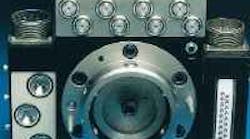NEW TECHNOLOGY AND DESIGN ELIMINATES TRADITIONAL TOOLCHANGER MAINTENANCE PROBLEMS.
By matching a specific tool to a specific task, toolchangers give a single robot the flexibility to complete multiple operations.
The ATI SW-150A toolchanger for transgun spot welding uses Rhodium-plated, male and female conical-shaped contacts that resist contamination.
On an increasing number of production lines, a single robot completes a number of tasks, from spot welding and metal removal to the palletizing of finished parts. Toolchangers provide the flexibility needed to match a specific tool to a specific task.
Unfortunately, conventional robotic toolchangers for resistance welding need a lot of maintenance. Under ideal conditions, the life of electrical contacts is predictable, running several million cycles before replacement. In the real world, the contacts are subjected to environmental contaminants and welding slag from adjacent operations. If contamination is not prevented, contacts can overheat, melt, arc, pit, corrode, and, in extreme cases, weld together.
A conventional repair requires complete disassembly of the high-power components, disconnection of cables, removal and replacement of contacts, then reassembly of the changer — a time-consuming, labor-intensive, and expensive process.
An ideal robotic toolchanger for resistance welding is low cost, low weight (under 30 pounds is ideal for transguns), and easy to maintain. It eliminates or greatly reduces damage to contacts. And, when contacts need replacement, the replacement process is quick and easy.
Also desirable is a high coefficient of volume (Cv); where higher water flow at lower pressure is available to cool transguns and transformers. And better fluid sealing eliminates air and water leaks.
ATI Industrial Automation, Garner, N.C., created such a system in its modular SW-150A toolchanger for transgun spot welding. On the ATI system, a master plate, attached to the robot with an interface plate, couples and uncouples tool plates. The spot-welding gun, and other tools such as grippers, additional guns, and so forth, are attached to the tool plates.
ATI uses its high-power module to address contamination and pitting problems common with high-power contacts. In this module, Rhodium-plated, male and female conical-shaped contacts resist contamination, unlike flat contacts that can trap weld slag when separated. The male contact is mounted on the tool assembly and the female contact is mounted on the master assembly of the toolchanger.
The Rhodium plating is a hard, precious metal that outperforms gold and silver for contact connections. Its high melting temperature reduces problems caused by welding slag and other contaminants.
For quick-change removal of the high-power contacts for maintenance, operators use a hex wrench while the master plate remains mounted to the robot and the tool plate is mounted to the gun.
The toolchanger also uses a fluid module with self-sealing air and fluid ports. A special low-friction seal prevents sticking of the valve seal, ensuring rapid sealing when the master disconnects from the tool.
The fluid module's 1.7 Cv increases water-flow volume by 20% to effectively cool the gun and transformer. This high flow also reduces or prevents clogging. Also, high acid pH problems, which may be associated with the available water supply, are neutralized. A proprietary Zicor coating protects the aluminum manifold from acid attack.
Another part of the toolchanger, the signal module, uses spring pins with Rhodium-plated tips to ensure the high-conductivity of precious-metal contact mating. An optional tool-identification switch mounted on the signal module is used to identify and select from one to eight tools. The toolchangers also have an air-actuated locking mechanism that includes patented ball-locking technology and position-sensing proximity sensors.
Transguns versus remote transformersWhen selecting robotic welding systems, shops can choose either transguns or remote transformers. With remote transformers, the contacts of the toolchangers must pass up to 20,000 amp, while voltage is only 6 V. Many people opt for the heavier, bulkier transguns to avoid electrical-contact problems. The ATI toolchanger for use with remote transformer systems provides the benefits of weight reduction — down to 40 lb compared to 80 lb — and compactness. The usual power module is replaced with two air cylinders that precisely mate two conical, Rhodium-coated contacts that easily handle the power. Energy savings is another benefit now that heavier cables are used and special insulators protect against generated heat. Normal shop air pressure automatically, snugly, and safely completes the clamping action. |








